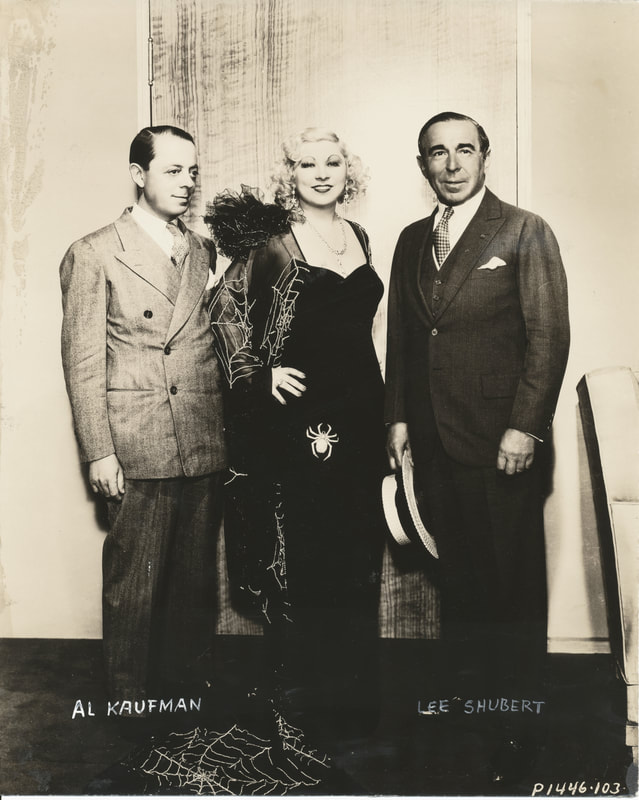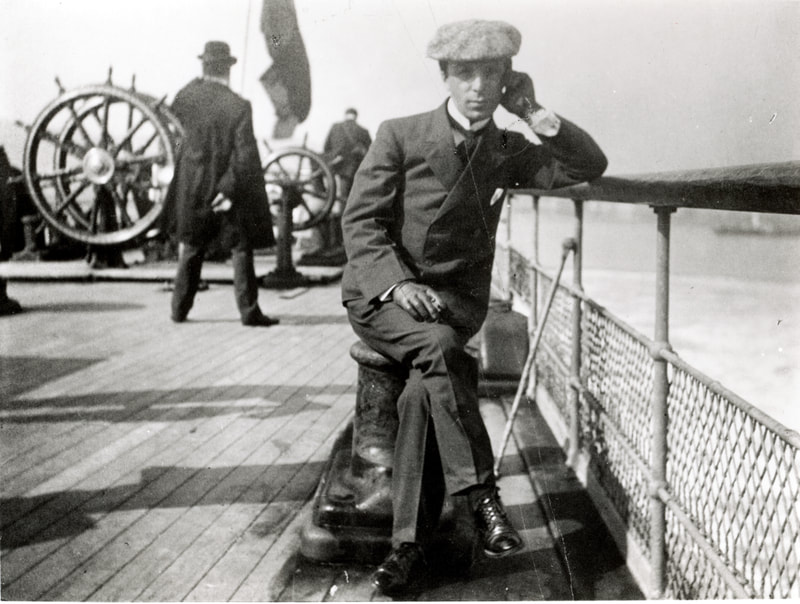Shubert Brothers
At the end of the 19th century, the three Shubert brothers -- Sam, Lee and J. J. -- operated theatres in Syracuse and other upstate New York cities, such as Buffalo, Rochester, Utica, Troy, and Albany. In 1900, Sam came to New York City and leased the Herald Square Theatre (NW corner, Broadway & 35th St.), the Shuberts' first venue in the city. Lee followed him to Manhattan shortly thereafter, while J.J. remained in charge of the upstate theatres. Before long, the Shuberts clashed with the Theatrical Syndicate, an organization of businessmen that had gained virtual control of the American theatre through their booking operations. The conflict continued for more than a decade until the Syndicate was no longer an effective force, and the Shubert brothers had established what was to become America's largest producing and theatre-owning operation.
Sam Shubert was killed in a railroad accident in 1905, just as he and his brothers were beginning their rise to power in the New York theatre. During the next quarter of a century, Lee and J.J. assembled a vast network of theatres from New York City to Portland, Oregon. On the eve of the Depression, the Shuberts owned, leased, operated, managed or booked around one thousand venues across the United States. They were also major producers, presenting some 500 plays and musical attractions.
Among their revues were Americana (1932), Artists and Models (various editions, 1923 on), At Home Abroad (1935), Greenwich Village Follies (various editions, 1921 on), Hellzapoppin' (1938), Hooray for What! (1937), Laffin' Room Only (1943), Life Begins at 8:40 (1934), The Passing Show (various editions, 1912 on), Priorities of 1942, The Show is On (1937), Sons o' Fun (1941), The Straw Hat Revue (1939), The Street of Paris (1939), and Ziegfeld Follies (various editions,1934 on). In the heyday of the operetta, ten companies of the Shubert production of The Student Prince (1924) were touring North America, crossing paths with companies of Blossom Time (1921), another Shubert hit. Other musicals the Shubert Brothers produced included The Belle of Bond Street (1914); A Chinese Honeymoon (1902); Countess Maritza (1926); The Earl and the Girl (1905); Emerald Isle (1902); Fantana (1905); Happyland (1905); Honeymoon Express (1913); Love o' Mike (1917); Maytime (1917); My Romance (1948); Nina Rosa (1930); Oh, I Say (1913); The Red Petticoat (1912); Robinson Crusoe, Jr. (1916); Runaways (1903); Sally, Irene and Mary (1922); Sinbad (1918); The Wonder Bar (1931); and, You Never Know (1938).
The Shuberts showcased many stars in their shows -- among them were Abbott & Costello, Fred Allen, Eve Arden, Fred and Adele Astaire, Avon Comedy Four, Josephine Baker, Tallullah Bankhead, Ethel Barrymore, Lionel Barrymore, Sarah Bernhardt, Ray Bolger, Fanny Brice, Burns & Allen, Eddie Cantor, Bobby Clark, Imogene Coca, Gaby Deslys, Marie Dressler, Eleanora Duse, Jeanne Eagles, Maxine Elliott, Lew Fields, Sir Johnston Forbes-Robertson, Lulu Glaser, Ruth Gordon, Cary Grant, Walter Hampden, Anna Held, Katharine Hepburn, Raymond Hitchcock, Bob Hope, De Wolf Hopper, Willie and Eugene Howard, George Jessel, Al Jolson, Bertha Kalich, Danny Kaye, Bert Lahr, Gypsy Rose Lee, Bea Lillie, Jeanette MacDonald, Richard Mansfield, Ilse Marvenga, Philip Merivale, Marilyn Miller, Carmen Miranda, Frank Morgan, Odette Myrtil, Alla Nazimova, Evelyn Nesbit, Olsen & Johnson, Anna Pavlova, Eleanor Powell, Lillian Russell, Ethel Shutta, Sothern and Marlowe, Vivian Vance, Lupe Velez, Ethel Waters, Clifton Webb, Mae West, Bert Williams, Walter Woolf, Peggy Wood, and Ed Wynn.
Behind the scenes, the Shuberts worked with such artists as Vincente Minnelli, Agnes deMille, George Balanchine, Ned Wayburn, and Ben Teal as well as a host of composers, lyricists, playwrights, and designers.
Lee Shubert died in 1953 and J. J. Shubert in 1963. John Shubert, J.J.'s son, was the chief executive of Shubert through the 1950s and the early 1960s. When John died suddenly in 1962, his cousin Lawrence Shubert Lawrence Jr. succeeded him and ran the company until 1972.
Sam Shubert was killed in a railroad accident in 1905, just as he and his brothers were beginning their rise to power in the New York theatre. During the next quarter of a century, Lee and J.J. assembled a vast network of theatres from New York City to Portland, Oregon. On the eve of the Depression, the Shuberts owned, leased, operated, managed or booked around one thousand venues across the United States. They were also major producers, presenting some 500 plays and musical attractions.
Among their revues were Americana (1932), Artists and Models (various editions, 1923 on), At Home Abroad (1935), Greenwich Village Follies (various editions, 1921 on), Hellzapoppin' (1938), Hooray for What! (1937), Laffin' Room Only (1943), Life Begins at 8:40 (1934), The Passing Show (various editions, 1912 on), Priorities of 1942, The Show is On (1937), Sons o' Fun (1941), The Straw Hat Revue (1939), The Street of Paris (1939), and Ziegfeld Follies (various editions,1934 on). In the heyday of the operetta, ten companies of the Shubert production of The Student Prince (1924) were touring North America, crossing paths with companies of Blossom Time (1921), another Shubert hit. Other musicals the Shubert Brothers produced included The Belle of Bond Street (1914); A Chinese Honeymoon (1902); Countess Maritza (1926); The Earl and the Girl (1905); Emerald Isle (1902); Fantana (1905); Happyland (1905); Honeymoon Express (1913); Love o' Mike (1917); Maytime (1917); My Romance (1948); Nina Rosa (1930); Oh, I Say (1913); The Red Petticoat (1912); Robinson Crusoe, Jr. (1916); Runaways (1903); Sally, Irene and Mary (1922); Sinbad (1918); The Wonder Bar (1931); and, You Never Know (1938).
The Shuberts showcased many stars in their shows -- among them were Abbott & Costello, Fred Allen, Eve Arden, Fred and Adele Astaire, Avon Comedy Four, Josephine Baker, Tallullah Bankhead, Ethel Barrymore, Lionel Barrymore, Sarah Bernhardt, Ray Bolger, Fanny Brice, Burns & Allen, Eddie Cantor, Bobby Clark, Imogene Coca, Gaby Deslys, Marie Dressler, Eleanora Duse, Jeanne Eagles, Maxine Elliott, Lew Fields, Sir Johnston Forbes-Robertson, Lulu Glaser, Ruth Gordon, Cary Grant, Walter Hampden, Anna Held, Katharine Hepburn, Raymond Hitchcock, Bob Hope, De Wolf Hopper, Willie and Eugene Howard, George Jessel, Al Jolson, Bertha Kalich, Danny Kaye, Bert Lahr, Gypsy Rose Lee, Bea Lillie, Jeanette MacDonald, Richard Mansfield, Ilse Marvenga, Philip Merivale, Marilyn Miller, Carmen Miranda, Frank Morgan, Odette Myrtil, Alla Nazimova, Evelyn Nesbit, Olsen & Johnson, Anna Pavlova, Eleanor Powell, Lillian Russell, Ethel Shutta, Sothern and Marlowe, Vivian Vance, Lupe Velez, Ethel Waters, Clifton Webb, Mae West, Bert Williams, Walter Woolf, Peggy Wood, and Ed Wynn.
Behind the scenes, the Shuberts worked with such artists as Vincente Minnelli, Agnes deMille, George Balanchine, Ned Wayburn, and Ben Teal as well as a host of composers, lyricists, playwrights, and designers.
Lee Shubert died in 1953 and J. J. Shubert in 1963. John Shubert, J.J.'s son, was the chief executive of Shubert through the 1950s and the early 1960s. When John died suddenly in 1962, his cousin Lawrence Shubert Lawrence Jr. succeeded him and ran the company until 1972.







